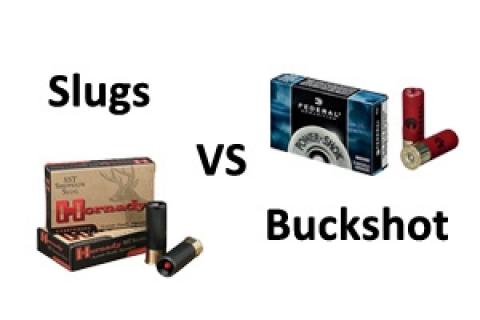
In a previous blog I talked about the pros and cons of shotguns vs. muzzleloaders for deer hunting. For those that choose a shotgun, this week I want to talk about the relative merits of slugs vs. buckshot.
 |
| Slugs offer more long-distance opportunities than buckshot. |
Slugs
As a teenager, the first deer I ever shot was taken with a full-choked smoothbore 20-gauge Browning Auto 5 shooting 3/4-oz Winchester rifled slugs. The gun was my bird gun, so all it had for sights was the front bead. It was a 50-yard gun, at best. Fortunately, advances in slugs and slug guns for deer have changed all that. Today, fully-rifled slug choke tubes or barrels are available for many makes and models of shotguns, in addition to special purpose slug guns with iron sights or scopes. The slugs themselves have also come a long way since the old Foster-type solid slugs that were the only real option a couple of decades ago.
Today there is a nearly endless variety of slug designs and constructions available in all gauges, including even .410 (not legal everywhere for deer, so check your local hunting regulations), including streamlined models that incorporate a plastic sabot for increased range and accuracy. These modern setups, when combined with a good scope, are capable of taking deer out to 150 yards, which is clearly the biggest advantage of slugs over buckshot.
The other big edge that slugs have is their sheer knockdown power. Let's face it, a chunk of lead or copper weighing as much as 11/4-oz travelling at velocities up to 1900 fps is going to do some serious damage. In my experience, few deer have run out of view after being well-hit with a slug.
There is such a wide selection of quality slugs available today that you should have no trouble finding a load that shoots well in your gun.
 |
| Buckshot makes it easier to hit moving targets in close quarters compared to slugs. |
Buckshot
Buckshot technology has also seen significant advances in the last 20 years or so, mainly in the areas of shot buffering and copper plating. Both of these additions mean longer ranges, better patterns and better penetration.
The brush-busting abilities of buckshot for hitting moving targets in close quarters and dense cover is where buckshot shines over slugs, and this has made them very popular for decades in the northeast and up into the big woods of Canada. Of course, the drawback is shorter range, usually not much over 50 yards or so; perhaps a bit more with a specialty buckshot choke tube.
If there is one knock on buckshot it is that on occasion deer have been known to go down instantly when hit with a load of buckshot, only to get up and run off a few moments later, when the hunter is not expecting it.
As with any shotgunning, loads must be tested in advance to make sure that they are producing acceptably tight patterns. Again, there is a wide selection of ammo available these days, so finding a good one is usually just a matter of trying a few different ones. Buckshot comes in sizes ranging from No. 4 at the small end, up to No. 000 at the big end. Obviously the larger sizes carry more knockdown power, but mean few pellets in the load, so experimenting to find the right load is key. Try to use the largest size that will pattern well in your gun.
Good hunting.
- 15430 views

